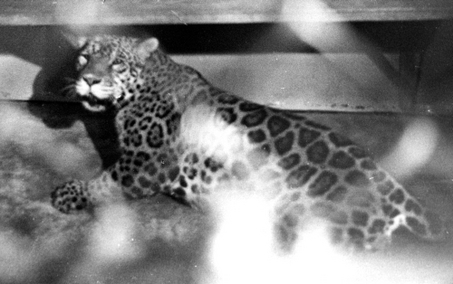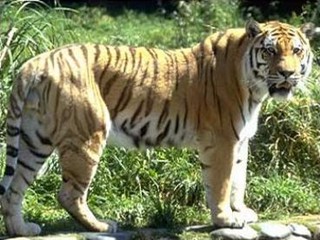
December 27, 2007

In December 1985, at the John Ball Zoo in Grand Rapids, Michigan, pregnant zookeeper Gayle Booth, 30, was fatally mauled by the above jaguar. Wild animals are dangerous, inside zoos and outside.
The mystery surrounding how the San Francisco Zoo’s tiger (below) escaped from the grotto may be slowly becoming solved. Human intervention could have been part of the cause.

San Francisco police are investigating the possibility that one of the victims in the fatal tiger mauling on Christmas Day climbed over a waist-high fence and then dangled a leg or other body part over the edge of a moat that kept the big cat away from the public, sources close to the investigation said Wednesday [December 26, 2007].
The minimal evidence found at the scene included a shoe and blood in an area between the gate and the edge of the 25- to 30-foot-wide moat, raising questions about what role, if any, the victims might have had in accidentally helping the animal escape.
The three victims, all young men from San Jose, were visiting the zoo together. They were all present just outside the tiger’s grotto when the tiger escaped, killed 17-year-old Carlos Sousa Jr. with a savage slash to the throat, and injured the other two. The names of the survivors, who are brothers ages 19 and 23, have not been released.
The injured victims fled, leaving a trail of blood, which police believe the tiger followed for 300 yards up a zoo pathway. As the tiger cornered and attacked one of the brothers, four police officers arrived, distracted the animal and shot it dead. For rest of article, see, “Trail of blood apparently led escaped tiger to victims,” by Kevin Fagan, Jaxon Van Derbeken, Steve Rubenstein,Cecilia M. Vega, San Francisco Chronicle Staff Writers, Thursday, December 27, 2007.

The above referenced article also contains this list:

S.F. Zoo incidents
Dec. 25, 2007: A Siberian tiger named Tatiana escapes and kills a 17-year-old San Jose boy and injures two brothers.
Dec. 22, 2006: Tatiana attacks and mauls zookeeper Lori Komejan, causing deep lacerations to her arms.
February 2001: A zoo employee is attacked and injured by the claws of a cassowary, a 5-foot-tall, 80-pound bird native to Northern Australia and New Guinea.
November 1994: Two Patas monkeys escape from the Primate Discovery Center. The monkeys are about 15 inches high and weigh around 35 pounds.
May 1990: Veteran zookeeper Alan Feinberg is attacked and bitten by a 90-pound Persian leopard as a crowd of schoolchildren watches in horror. The keeper is treated for deep wounds to his head and neck.
February 1990: A keeper suffers a lower back fracture after being knocked into a 10-foot-deep moat by Tinkerbelle, a 7,000-pound elephant.
October 1988: Tinkerbelle attacks animal health technician Gail Hedberg, who was treating the elephant for an abscess on its cheek. The elephant knocks the technician down and does a headstand on her. Hedberg suffers a crushed pelvis.
July 1985: Two Patas monkeys escape from the zoo and remain at large for six weeks before being recaptured behind the University of California medical complex on Mount Sutro.
April 1980: Five female City College students are caught fording the moat around Monkey Island. Police officers find a dead spider monkey in a duffel bag floating in the moat. The women are later given suspended jail sentences and six months’ probation.
January 1979: A male Indian elephant injures keepers, knocking one into the moat.
November 1976: A 175-pound South American jaguar escapes from the zoo’s animal hospital, where it was recovering from cracked footpads. Zoo director Saul Kitchener fells the animal, named Buster, with a dart from a tranquilizer gun.
February 1976: An antelope leaps over a damaged fence and knocks a visitor to the ground, causing head injuries.
March 1972: A 3-year-old girl suffers a broken jaw and deep facial cuts when a camel leans over a fence and bites the child in the face. It drags her over the fence and tramples her.
March 1971: A 300-pound female tapir escapes from her compound and is found wandering on Sloat Boulevard. The tapir bounds over two police cars, denting both, and then knocks a police officer to the ground.
August 1969: An escaped chimpanzee bites two keepers.
April 1968: Amos Watson, a visitor, is mauled by a 450-pound lion, suffering puncture wounds over most of his body. Watson had climbed over a rail and tumbled into the moat. The lion is killed by one shot from a keeper’s rifle.
August 1967: Zookeeper Robert Caldwell is badly bitten by a 400-pound orangutan. He was alone near the Great Ape Grotto when Big Red, the male orangutan, reached under the mesh-covered bars and grabbed Caldwell’s left arm, pulling it into the cage. Then Linda, a female orangutan, chewed on the keeper’s arm.
November 1962: May, a 6,000-pound elephant, attacks her keeper, battering him with her trunk and butting him with her head.
December 1960: A 500-pound lion reaches between the bars of its cage and hooks the arm of a keeper, who has to undergo two hours of surgery for his injuries.
May 1960: A 125-pound black leopard attacks a keeper who had been feeding the animal.
March 1949: A polar bear reaches through the bars of its cage and hooks a visitor’s arm.
Wild animals kept in zoos remain wild. Although we rarely hear about them, animal attacks happen all the time. Right before the deathly Royal Bengal tiger incident in San Francisco, a man was killed by a Royal Bengal tiger at a zoo in Assam, India.
At Guwahati, India, on Wednesday, December 19, 2007, a man trying for a better photo of the largest subspecies of tiger in a zoo in India was mauled to death when a second tiger grabbed him as his family looked on in horror.
Jayprakash Bezbaruah, 50, of Sivasagar, went past a barrier at the tiger exhibit at Assam State Zoo in Guwahati and stretched through an iron railing with his digital camera to get a shot of a relaxing tigress named Divya. He didn’t see the second tiger, Govardana, which grabbed his arm and Divya quickly joined in the attack.
Bezbaruah’s left arm was torn off and one of the cats clawed his face in front of his wife, two sons, a relative and other zoo visitors. Zookeeper Bapukon Baishya beat back the tigers with a stick and Bezbaruah was taken to a hospital where he was pronounced dead on arrival.
Meanwhile, that same day, in another incident, wildlife officials tranquillised a leopard in the heart of Guwahati after the cat was reported to have been roaming the streets. The leopard had attacked and killed several goats and chickens in the area before being captured and sent to the zoo.
Internationally, there have been other captive animal attacks.
On Friday, February 9, 2007, panic gripped the visitors at Dhaka Zoo, Bangladesh, at noon when a Royal Bengal Tiger attacked its food provider inside the cage, came out of it and roamed the zoo premises for about half an hour. Finally, the zoo used a tranquillizer gun to make the tiger unconscious and carried it back to the cage. It took 14 people to carry the animal. At the Dhaka Zoo, a zoo tiger killed a visitor child in 1996 when he went close to its cage and a bear killed a zoo staff in 2004.
On Sunday, February 11, 2007, Karen Aerts, 37, entered the cheetah cage at the Olmense Zoo in Belgium and was mauled to death. One of the cats that killed her was named Bongo. Aerts had adopted Bongo under a special program, paying for food for the cat. She hid somewhere in the park after it closed and managed to find the keys to the cheetah cage.
On February 22, 2007, a six-year-old girl was mauled to death by a perfoming tiger at the Kunming Zoo, Yunnan province, China, as she was being photographed with the animal. It reacted to a flashbulb. The male tiger had been performing at the zoo since May 2005. Visitors paid around $2.40 for a photo with the animal.
The Associated Press has published a list, as well. I have added some other incidents to it:
List of Maulings by Captive Animals
Some maulings and other incidents involving captive animals in the United States:
Dec. 25, 2007: A Siberian tiger named Tatiana escapes from its enclosure at the San Francisco Zoo, killing one man and mauling two others, before being shot dead.
Feb. 24, 2007: A 140-pound jaguar named Jorge fatally mauls a zookeeper at the Denver Zoo before being fatally shot. Zoo officials said later that zookeeper Ashlee Pfaff had violated the rules by opening the door to the animal’s cage.
Dec. 22, 2006: Tatiana reaches through her cage’s iron bars and mauls a female zookeeper during a public feeding at the San Francisco Zoo.
Dec. 22, 2006: The National Zoo in Washington is briefly shut down after a clouded leopard bolts from a wire-mesh enclosure. It is found snoozing just outside the exhibit 30 minutes later.
Nov. 29, 2006: Trainer Kenneth Peters, 39, is bitten and held underwater several times by a 7,000-pound killer whale during a show at Shamu Stadium at SeaWorld Adventure Park. Peters escaped with a broken foot. The 17-foot-long orca is the dominant female of SeaWorld San Diego’s seven killer whales. She had attacked Peters on two prior occasions, in 1993 and 1999.
Sept. 10, 2005: Three chimpanzees from Zoo Nebraska are shot and killed after they escape from their enclosure and could not be captured. A padlock on the cage was not completely closed after being cleaned, officials at the zoo in Royal, Neb., said.
March 3, 2005: Two chimpanzees at the Animal Ranch wildlife sanctuary near Bakersfield, Calif., attack a man and his wife, maiming the man, before being shot to death.
July 13, 2004: A state wildlife officer fatally shoots a 600 pound tiger that escaped from the property of former Tarzan actor Steve Sipek in Loxahatchee, Fla.
March 18, 2004: A 340-pound gorilla named Jabari breaks out of its enclosure at the Wilds of Africa exhibit at the Dallas Zoo and goes on a 40-minute rampage through a forest, snatching up a toddler with his teeth and attacking three other people before being shot to death by officers.
Oct. 3, 2003: Illusionist Roy Horn is severely mauled by a tiger during the Siegfried & Roy nightly show at The Mirage casino in Las Vegas, biting him in the neck and dragging him off stage.
Sept. 28, 2003: A 300-pound gorilla named Little Joe escapes from its enclosure at Boston’s Franklin Park Zoo, attacking a 2-year-old girl and a teen-age zoo employee, before being tranquilized. It was the second time in two months that the animal escaped.
Aug. 7, 2002: A catwalk over a shark tank collapses at New Orleans’ Aquarium of the Americas, throwing 10 visitors into the water. The 10, including four children, thrash around in terror for up to 15 minutes with the sharks swimming beneath their kicking feet before they were pulled out. No one is seriously hurt.
2002: A six-year-old boy was attacked at an elementary school near Santa Cruz, California. It happened when a wildlife education group brought in a tiger for “show and tell.” He needed 55 stitches on his head.
1998: At Marine World in Vallejo, California, a woman was attacked while posing for a photo with a Bengal tiger. The animal slashed her, causing serious injuries to her face and torso.
Dec. 8, 1985: At the John Ball Zoo, in Grand Rapids, Michigan, zookeeper Gayle Booth, 30, of Kent City, was making final rounds when she was attacked by a 180-pound male jaguar that apparently squeezed through a flawed doorway to gain entrance to a holding area used by workers. The jaguar fatally mauled the pregnant zookeeper.
About Loren Coleman
Loren Coleman is one of the world’s leading cryptozoologists, some say “the” leading living cryptozoologist. Certainly, he is acknowledged as the current living American researcher and writer who has most popularized cryptozoology in the late 20th and early 21st centuries.
Starting his fieldwork and investigations in 1960, after traveling and trekking extensively in pursuit of cryptozoological mysteries, Coleman began writing to share his experiences in 1969. An honorary member of Ivan T. Sanderson’s Society for the Investigation of the Unexplained in the 1970s, Coleman has been bestowed with similar honorary memberships of the North Idaho College Cryptozoology Club in 1983, and in subsequent years, that of the British Columbia Scientific Cryptozoology Club, CryptoSafari International, and other international organizations. He was also a Life Member and Benefactor of the International Society of Cryptozoology (now-defunct).
Loren Coleman’s daily blog, as a member of the Cryptomundo Team, served as an ongoing avenue of communication for the ever-growing body of cryptozoo news from 2005 through 2013. He returned as an infrequent contributor beginning Halloween week of 2015.
Coleman is the founder in 2003, and current director of the International Cryptozoology Museum in Portland, Maine.
Filed under Alien Big Cats, Breaking News, Cryptomundo Exclusive, Cryptotourism, CryptoZoo News, Cryptozoologists, Cryptozoology, Media Appearances